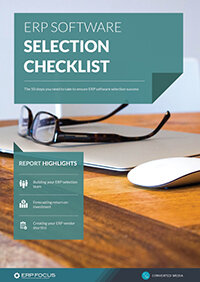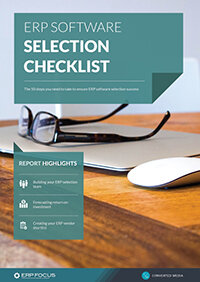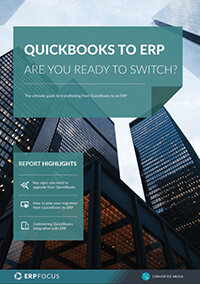Factors to consider before implementing an ERP upgrade
Your ERP system is the core engine that drives your operational performance. When it falters, so does your efficiency, productivity, and agility. Despite this, the prospect of a brand new system, or even an upgrade, can feel daunting. Both physically and financially. Take the risk out of deciding whether to stick or twist by considering whether the change is necessary.
It might be time to consider an alternative ERP if:
- Your old ERP lacks mobility.
- There is a new system that offers another business critical function that your current system lacks.
- Your employees are dissatisfied with your outdated interfaces enough to cause retention issues.
- Your ERPs infrastructure of software is no longer supported by your vendor or wider technical talent pool.
Use our free ERP features guide to create a list of requirements for your new ERP system
A brand new ERP system can run from 5 to 6 figures and take 8 months or more to implement for a mid-sized enterprise. It’s a significant time and financial investment. It may be cheaper and quicker to upgrade your existing system to a more recent version. If a newer version meets your criteria, saves you time and a chunk of change, it will be preferable to throwing out everything and starting from scratch. However, some newer versions might be so significantly changed that the upgrade could be almost as time-consuming and costly as an entirely new system. This is why it’s critical to put the same effort into your ERP functionality checklist and RFP for an upgrade as it would be if you were investing for the first time.
What steps you need to take for a successful ERP upgrade
You’ve decided you aren’t seeing the efficiency and ROI that your ERP used to deliver. Change is definitely needed. But what steps should you take for your ERP upgrade to triumph?
1. Review the usage of your existing ERP
Have you used your existing ERP to its fullest capabilities? First, ask yourself if you really need an upgrade or if you are simply not using its full functionality. It’s easy to fall into the trap of low user adoption, failure to keep a system maintained or to not have the right training and support to get the most out of your system. If you’re confident that you have ticked all the boxes on successful ERP adoption, then you can safely move onto the next step. However, if you haven’t addressed all these potential issues, you’ll simply carry them over into the next rollout while pouring cash and resources down the drain.
2. Plan the full project scope
Yes, it’s arduous. Yes, it’s hard work. But this is crucial to making the right choice ahead of any investment or next steps. If you need some help to identify the features and modules your new ERP should have, this ERP features list should help.
3. Create a steering committee
This team should be a mix of management with relevant experience and users from each business unit. Together, they will check through your proposed scope and help with the actual rollout when the implementation is underway. The representatives should be able to identify:
- Essential functionality that affects productivity
- Existing processes and how well they work
- User challenges they’ve faced with the existing system
- Resources needed (in-house and consultants/contractors)
- Budget availability
Take a look at this example ERP implementation team structure to help build your ideal committee.
4. Build an ERP vendor shortlist
This may or may not include existing partners. Get vendor-specific insights from your peers and online reviews. Consider whether they can offer the right level of support and future-proofing as well as gauging rough price points against your budget to create your ideal shortlist.
You can use a Request for Information (RFI) document to get direct details from potential suppliers. They will typically respond with top-level information such as accreditations, values, and offerings to help you align and narrow down your list.
5. Create an RFP
Now you’ve filtered out any obviously ill-fitting vendors, it’s time to probe deeper with your new shortlist. The RFP should outline your needs and business challenges to help the vendors provide you with a fitting proposal. This will help you further define your checklist of requirements ready for the next step.
Check out our ERP software RFP guide including your RFP structure-cheat sheet
6. Send out your RFQ
Using your checklist, scope, and steering committee input, create an RFQ to send to vendors. This should include technical requirements as well as SLA expectations, timelines, and contract length. You might already have significant enough input from your RFP responses but in case you need further detail, you might consider sending an RFQ. This will be a full breakdown of costs with technical specs and SLAs.
7. Evaluate the responses and make your choice
Involve your steering committee and project management teams to go through each response. Go back to your initial checklist. Ask yourselves if anything has changed during your discovery process. Beware of being oversold too. There might be enticing features among the proposals, but if they don’t address a genuine business pain point, they are not relevant. Unless they are free of course!
8. Make a plan with your chosen vendor
The planning, timelines spec, and expectations outlined in the quote need to be formalized into a contractual agreement. Once you have this agreement in place, it’s time to make a plan with your supplier. They may have their own training resources, consultants and other talent at your disposal. Make sure your project management team includes these resources and is streamlined accordingly.
Ensuring you have followed each step in a formalized process with the right team and vendor will make your ERP switch far more likely to give you an ROI within your deadline. However, these are just the main steps leading up to the implementation. Whether you’re upgrading or taking on a completely new system, there is a whole new set of challenges awaiting you at rollout stage and beyond. Make sure you’re ready to tackle ongoing support, training, user feedback and technical issues. Implementation is just the beginning, but a strong start will help you avoid future pitfalls.
Free white paper

60-Step ERP Selection Checklist
Get the comprehensive checklist for your ERP selection project

Featured white papers
-

ERP Software Pricing Guide
Get the latest pricing information on over 80 popular ERP systems, and learn how to budget for your ERP project in our free guide
Download -

60-Step ERP Selection Checklist
Get the comprehensive checklist for your ERP selection project
Download -

Quickbooks to ERP: Are You Ready to Switch?
Get the definitive guide to converting your business from Quickbooks to ERP
Download
Related articles
-

The best ERP systems for process manufacturing
Consider these ERP systems when selecting your next process manufacturing ERP
-

CMMC Compliance: What Aerospace and Defense Manufacturers Need to Know
Key insights on CMMC compliance, deadlines, and securing DoD contracts with CMMC 2.0 certificatio...
-

5 ERP pricing definitions you need to understand
Have you mastered the ERP pricing lexicon yet? Getting to grips with these five definitions is a ...

